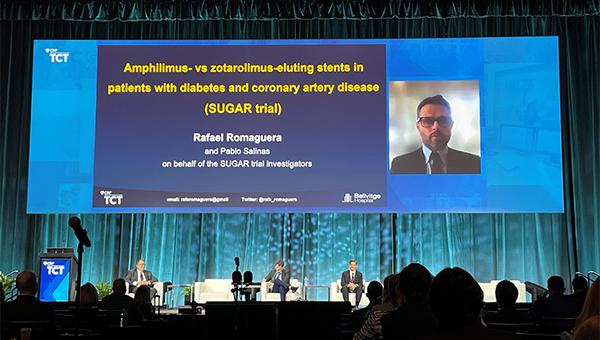‘Sweet Like SUGAR’: Polymer-Free Stent Noninferior to ZES in Diabetic Patients
Though results are impressive to some, others say a totality of evidence is needed before the stent can be routinely adopted.

Among patients with diabetes and coronary artery disease, a polymer-free, amphilimus-eluting stent is noninferior to a permanent-polymer zotarolimus-eluting stent (ZES) with respect to target lesion failure at 1 year, results from the investigator-initiated SUGAR trial show.
The thin-strut, polymer-free Cre8 stent (Alvimedica) was already shown to be noninferior to the Resolute Integrity ZES (Medtronic) in an all-comers population through 3 years, but investigators have previously suggested the newer device might be especially useful in diabetics given the amphilimus formulation, which might enable higher drug diffusion across the vessel wall.
SUGAR, presented today in a late breaking trial session at TCT 2021 and published in the European Heart Journal, showed a 35% relative risk reduction for the primary endpoint of TLF (defined as a composite of cardiac death, target-vessel MI, and clinically indicated target lesion revascularization) at 1 year among 586 patients with diabetes randomized to the second-generation Cre8 EVO stent compared with 589 assigned to receive Resolute Onyx (Medtronic; P < 0.001 for noninferiority, with the noninferiority margin set at 4%). A prespecified exploratory analysis also demonstrated superiority (P = 0.03).
“Further follow-up is needed, but this stent should be considered as an option for treating patients with diabetes mellitus and coronary artery disease,” study presenter Rafael Romaguera, MD (Bellvitge University Hospital, Barcelona, Spain), told TCTMD. As the stent has CE Mark approval for use in Europe, he added that the results of SUGAR have encouraged him to use Cre8 as his preferred device for “most patients with diabetes.”
However, he noted, the Resolute Onyx stent may hold a slight edge in terms of deliverability in patients with particularly calcified, tortuous, or long lesions and remains a viable option.
“Data like this from a well-conducted, independent trial would lead me to consider very seriously preferential use of this stent in patients with diabetes,” Robert A. Byrne, MBBCh, PhD (Mater Private Hospital, Dublin, Ireland), who was not involved in the study, told TCTMD. “Heretofore, we had thought that all of the newer-generation DES that were sirolimus-analog based had broadly similar efficacy, but the theory behind this stent suggests that it might perform better in patients with diabetes and the data from this trial appears to show that.”
In a press conference where the data were presented, moderator Roxana Mehran, MD (Icahn School of Medicine at Mount Sinai, New York, NY), called the results “astounding” and “almost too good to be true.”
Likewise, panelist Gennaro Sardella, MD (Sapienza University of Rome, Italy), said, “This study is sweet like sugar for us, because now we have a stent that is dedicated and fitted for diabetic population.”
Noninferiority Shown, Superiority Suggested
For the investigator-initiated study, Romaguera and colleagues enrolled 1,175 patients with diabetes and CAD from 23 centers in Spain with no limitations on clinical presentation or complexity, number of lesions, or presence of left main disease. Mean was around 68 years, and about three-quarters were male. About half of patients had multivessel disease.
Of the 586 randomized to receive the Cre8 EVO stent, only five did not receive it, with three crossing over, one given a nonstudy stent, and one given no stent. Likewise, two of the 589 patients randomized to receive the Resolute Onyx stent did not end up receiving it, with one patient crossing over and one given a nonstudy stent. Most patients in both the Cre8 EVO and Resolute Onyx groups were on dual antiplatelet therapy (DAPT) at 1 month (94.2% vs 94.1%; P = 0.919) and 6 months (86% vs 85.6%; P = 0.830), but fewer in the investigational arm were still taking DAPT at 1 year (53.6% vs 59.3%; P = 0.05).
TLF at 1 year was lower for those who received the Cre8 EVO stent compared with Resolute Onyx (7.2% vs 10.9%; HR 0.65; 95% CI 0.44-0.96). Among the secondary outcomes, target vessel failure was significantly lower in the study population, and there were no differences in definite/probable stent thrombosis, all-cause death, or MACE.
One-Year Outcomes
|
|
Cre8 (n = 586) |
Resolute Onyx (n = 589) |
HR (95% CI) |
|
Target Lesion Failure |
7.2% |
10.9% |
0.65 (0.44-0.96) |
|
Cardiac Death |
2.1% |
2.7% |
0.75 (0.36-1.59) |
|
Target Vessel MI |
5.3% |
7.2% |
0.74 (0.44-1.23) |
|
Target Lesion Revascularization |
2.4% |
3.9% |
0.60 (0.31-1.18) |
|
Target Vessel Failure |
7.5% |
11.1% |
0.67 (0.46-0.99) |
|
Definite/Probable Stent Thrombosis |
1.4% |
1.4% |
1.00 (0.38-2.67) |
|
All-Cause Mortality |
3.4% |
5.0% |
0.69 (0.39-1.22) |
|
MACE |
11.7% |
15.7% |
0.74 (0.53-1.02 |
Romaguera pointed to the rise in TLR events seen at the 7-8 month mark in the Resolute Onyx group, something not seen in the Cre8 EVO arm, as a driver of the latter stent’s benefit. “For the Resolute Onyx, the stent releases the drug up to 6 months,” he explained. “So the restenosis became apparent after that point.”
Moreover, he said Cre8 EVO has three features that make it particularly attractive. First, it is substantially thinner given that it does not have a polymer. The lack of polymer also leads to less inflammation on the vessel wall. “The third is that the drug efficacy is very high,” Romaguera said.
Based on prior research, the Cre8 EVO stent “is also safe for high bleeding risk patients,” he continued. “If you implant another stent in a high bleeding risk patient and then that patient has a TLR, this patient will need prolonged DAPT, so you have a second problem. So it's especially important for high-bleeding-risk patients to implant this stent.”
Gardella agreed that “efficacy and safety are very interconnected” when it comes to DES outcomes, noting: “If you have less-efficient DES, you have to restart the DAPT, and thus you could have more bleeding.”
Whether the curves, especially with regard to TLR, will continue to diverge remains to be seen, he observed. “For this reason, we have a prespecified coprimary endpoint at 2 years for superiority,” Romaguera said, adding that these data will likely be presented at TCT 2022.
The device is available in many countries around the world. Romaguera said that although the manufacturer once had plans for a US pivotal trial, he has not heard any further updates about that starting.
‘Stands on Its Own’
Byrne, who had previously called for more evidence looking at the Cre8 stent within a diabetic population, said, “This is exactly the type of data we wanted to see with this device because the mechanism of action of the coating suggests that it might have advantage in patients with diabetes against the standard stents, and the results are quite impressive.”
He further explained that the margin of noninferiority used in the study was “reasonably generous” in that the event rates observed “were broadly in line with the assumptions they had made.”
Given the low rate of crossover, Byrne said it seems like the Cre8 EVO stent can be easily delivered, although he has no personal experience with it. “It's important because it tends to be somewhat selected patients that are include in randomized trials and we have to extrapolate their performance to the patients that weren't eligible for inclusion or weren't included in the trial and deliverability can be an issue there,” he said.
Overall, Byrne concluded, “I think it's an impressive contribution and while I'd like to see it replicated at some stage in the future, I wouldn't overemphasize that point because I think it stands on its own.”
These data aren’t the end of the story, said Shmuel Banai, MD (Tel Aviv Medical Center, Israel), also commenting during the press conference. “One-year follow-up with DES is never sufficient, but the results first of all make sense and are very promising,” he said. “Longer-term follow-up are needed, but this is very promising and I'm very happy about this study.”
Similarly, panelist David Kandzari, MD (Piedmont Heart Institute, Atlanta, GA), also urged a wait-and-see approach. For one particular stent to be adopted as the standard in the diabetic population, “there needs to be biologic plausibility,” which is supported but not proven in the current study, he said. “And secondly I think we need a theme of data, a larger evidence base, to then make that change.”
Yael L. Maxwell is Senior Medical Journalist for TCTMD and Section Editor of TCTMD's Fellows Forum. She served as the inaugural…
Read Full BioSources
Romaguera R, Salinas P, Gomez-Lara J, et al. Amphilimus- versus zotarolimus-eluting stents in patients with diabetes mellitus and coronary artery disease (SUGAR trial). Eur Heart J; 2021:Epub ahead of print.
Disclosures
- The SUGAR trial was funded by the Spanish Society of Cardiology.
- Romaguera reports receiving consultant fee/honoraria/speaker's bureau (personal) from Biotronik and Boston Scientific Corporation.
- Banai reports serving as a medical director for Neovasc.
- Mehran reports grant support/research contracts (institutional) from Abbott Vascular, AstraZeneca, Bayer AG, Bristol-Myers Squibb, CSL Behring, Daiichi-Sankyo/Eli Lilly and Company, Medtronic, Novartis Pharmaceuticals, OrbusNeich, CERC, Chiesi, Concept Medical, Applied Therapeutics, Beth Israel Deaconess, Zoll, Arena, Biosensors, Boston Scientific, CellAegis, Insel Gruppe AG, Philips, and Transverse Medical; consultant fees/honoraria/speakers bureau fees (personal) from Medscape/WebMD, Janssen Scientific Affairs, Cine Med Research, ACC, CIRM, SCAI, and WebMD; equity < 1% (personal) from Elixir Medical, Applied Therapeutics, and STEL; equity < 1% to her spouse (personal) from ControlRad; advisory board payments (institutional) from Idorsia Pharmaceuticals; scientific advisory board payments (personal) from the AMA; consultant fees/honoraria/speakers bureau fees (institutional) from Abbott Vascular, Abiomed, AM-Pharma, Alleviant, Bayer, Beth Israel Deaconess, CardiaWave, CeloNova, Chiesi, Concept Medical, DSI, Duke University, Idorsia Pharmaceuticals, Medtronic, Novartis, and Philips; divested equity < 1% (institutional) from Claret Medical (now Boston Scientific); and scientific advisory board payments to her spouse (personal) from Biosensors.
- Kandzari reports holding equity/stock(s)/options in Biostar Ventures (personal); receiving grant support/research contract (institutional) from Medtronic, Teleflex, Abbott Vascular, CSI, and Biotronik; and receiving consultant fee/honoraria/speaker's bureau (personal) from CSI.
- Byrne and Sardella report no relevant conflicts of interest.




Comments